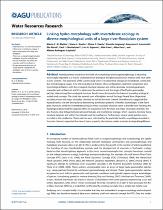 ResearchSpace
ResearchSpace
Linking hydro-morphology with invertebrate ecology in diverse morphological units of a large river-floodplain system
JavaScript is disabled for your browser. Some features of this site may not work without it.
- ResearchSpace
- →
- Research Publications/Outputs
- →
- Journal Articles
- →
- View Item
| dc.contributor.author |
Blettler, MCM

|
|
| dc.contributor.author |
Amsler, ML

|
|
| dc.contributor.author |
Eberle, EG

|
|
| dc.contributor.author |
Szupiany, R

|
|
| dc.contributor.author |
Oberholster, Paul J

|
|
| dc.date.accessioned | 2017-07-28T08:59:01Z | |
| dc.date.available | 2017-07-28T08:59:01Z | |
| dc.date.issued | 2016-12 | |
| dc.identifier.citation | Blettler, M.C.M., Amsler, M.L., Eberle, E.G. et al. 2016. Linking hydro-morphology with invertebrate ecology in diverse morphological units of a large river-floodplain system. Water Resources Research, vol. 52(12): 9495-9510. DOI: 10.1002/2016WR019454 | en_US |
| dc.identifier.issn | 0043-1397 | |
| dc.identifier.uri | http://onlinelibrary.wiley.com/doi/10.1002/2016WR019454/full | |
| dc.identifier.uri | DOI: 10.1002/2016WR019454 | |
| dc.identifier.uri | http://hdl.handle.net/10204/9308 | |
| dc.description | Water Resources Research, vol. 52(12): 9495-9510 | en_US |
| dc.description.abstract | Interdisciplinary research in the fields of ecohydrology and ecogeomorphology is becoming increasingly important as a way to understand how biological and physical processes interact with each other in river systems. The objectives of the current study were 1) to determine changes in invertebrate community due to hydrological stages, 2) to link local physical features [flow configuration, sediment composition and morphological feature) with the ecological structure between and within dissimilar morphological units (meander and confluence), and 3) to determine the existence and the origin of bed hydro-geomorphic patches, determining their ecological structure. Results were discussed in the frame of prevailing ecological models and concepts. The study site extends over a floodplain area of the large Paraná River (Argentina), including minor and major secondary channels as well as the main channel. Overall results suggested that hydrodynamics was the driving force determining distribution patterns of benthic assemblages in the floodplain. However, while the invertebrates living in minor secondary channels seem to benefit from flooding, this hydrological phase had the opposite effect on organisms from the main and major secondary channels. We also found a clear linkage between physical features and invertebrate ecology, which caused a dissimilar fauna structure between and within the meander and the confluence. Furthermore, several sandy-patches were recorded in the confluence. These patches were colonized by the particular benthic assemblage recorded in the main channel, supported the view of rivers as patchy discontinua, under uncertain ecological equilibrium. | en_US |
| dc.language.iso | en | en_US |
| dc.publisher | AGU Publications, Wiley | en_US |
| dc.relation.ispartofseries | Worklist;18603 | |
| dc.subject | Hydrodynamics | en_US |
| dc.subject | Hydro-morphology | en_US |
| dc.subject | Large river-floodplain system | en_US |
| dc.subject | Sandy-patches | en_US |
| dc.title | Linking hydro-morphology with invertebrate ecology in diverse morphological units of a large river-floodplain system | en_US |
| dc.type | Article | en_US |
| dc.identifier.apacitation | Blettler, M., Amsler, M., Eberle, E., Szupiany, R., & Oberholster, P. J. (2016). Linking hydro-morphology with invertebrate ecology in diverse morphological units of a large river-floodplain system. http://hdl.handle.net/10204/9308 | en_ZA |
| dc.identifier.chicagocitation | Blettler, MCM, ML Amsler, EG Eberle, R Szupiany, and Paul J Oberholster "Linking hydro-morphology with invertebrate ecology in diverse morphological units of a large river-floodplain system." (2016) http://hdl.handle.net/10204/9308 | en_ZA |
| dc.identifier.vancouvercitation | Blettler M, Amsler M, Eberle E, Szupiany R, Oberholster PJ. Linking hydro-morphology with invertebrate ecology in diverse morphological units of a large river-floodplain system. 2016; http://hdl.handle.net/10204/9308. | en_ZA |
| dc.identifier.ris | TY - Article AU - Blettler, MCM AU - Amsler, ML AU - Eberle, EG AU - Szupiany, R AU - Oberholster, Paul J AB - Interdisciplinary research in the fields of ecohydrology and ecogeomorphology is becoming increasingly important as a way to understand how biological and physical processes interact with each other in river systems. The objectives of the current study were 1) to determine changes in invertebrate community due to hydrological stages, 2) to link local physical features [flow configuration, sediment composition and morphological feature) with the ecological structure between and within dissimilar morphological units (meander and confluence), and 3) to determine the existence and the origin of bed hydro-geomorphic patches, determining their ecological structure. Results were discussed in the frame of prevailing ecological models and concepts. The study site extends over a floodplain area of the large Paraná River (Argentina), including minor and major secondary channels as well as the main channel. Overall results suggested that hydrodynamics was the driving force determining distribution patterns of benthic assemblages in the floodplain. However, while the invertebrates living in minor secondary channels seem to benefit from flooding, this hydrological phase had the opposite effect on organisms from the main and major secondary channels. We also found a clear linkage between physical features and invertebrate ecology, which caused a dissimilar fauna structure between and within the meander and the confluence. Furthermore, several sandy-patches were recorded in the confluence. These patches were colonized by the particular benthic assemblage recorded in the main channel, supported the view of rivers as patchy discontinua, under uncertain ecological equilibrium. DA - 2016-12 DB - ResearchSpace DP - CSIR KW - Hydrodynamics KW - Hydro-morphology KW - Large river-floodplain system KW - Sandy-patches LK - https://researchspace.csir.co.za PY - 2016 SM - 0043-1397 T1 - Linking hydro-morphology with invertebrate ecology in diverse morphological units of a large river-floodplain system TI - Linking hydro-morphology with invertebrate ecology in diverse morphological units of a large river-floodplain system UR - http://hdl.handle.net/10204/9308 ER - | en_ZA |





